It might easily have never happened. Whatever impulse it is that seems to either grant us free will or creates the illusion might never have twitched within me. But twitch it did, and so I entered the Anker — the ubiquitous chain bakery of Austria — and bought myself a Punschkrapfen. I don’t think I even knew it was a Punschkrapfen until I read the label set before the bright pink cube of fondant covered cake beneath the perspex counter. I bought one and took it at onto the street and ate it at once, like an apple. I did not anticipate how sweet, dense, and heavy it would be. It would have been impossible to anticipate. I felt like I was doing something indecent in public. Had I not been in Europe, then undoubtedly I would have been.
Tag: vienna
Vienna Diary, July 17th
The streets of Vienna are graced by the works of a particularly distinguished graffiti artist. Their work is immediately identifiable. It isn’t the usual typographical fare, nor the sweeping lines and sharp angles of spray can work, nor even the uniformity of stencils. With nothing more than a thick black permanent marker, the profile has become the stand out feature of the city floor gallery, with all the ligne claire flaire I’d hope for from a European.

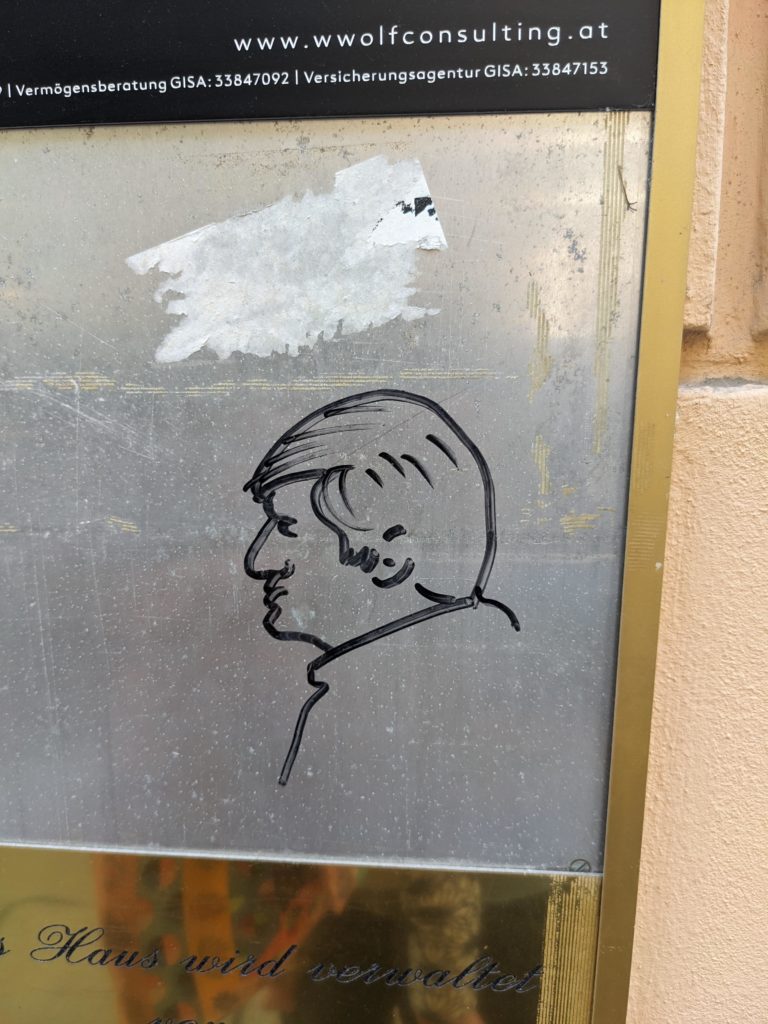




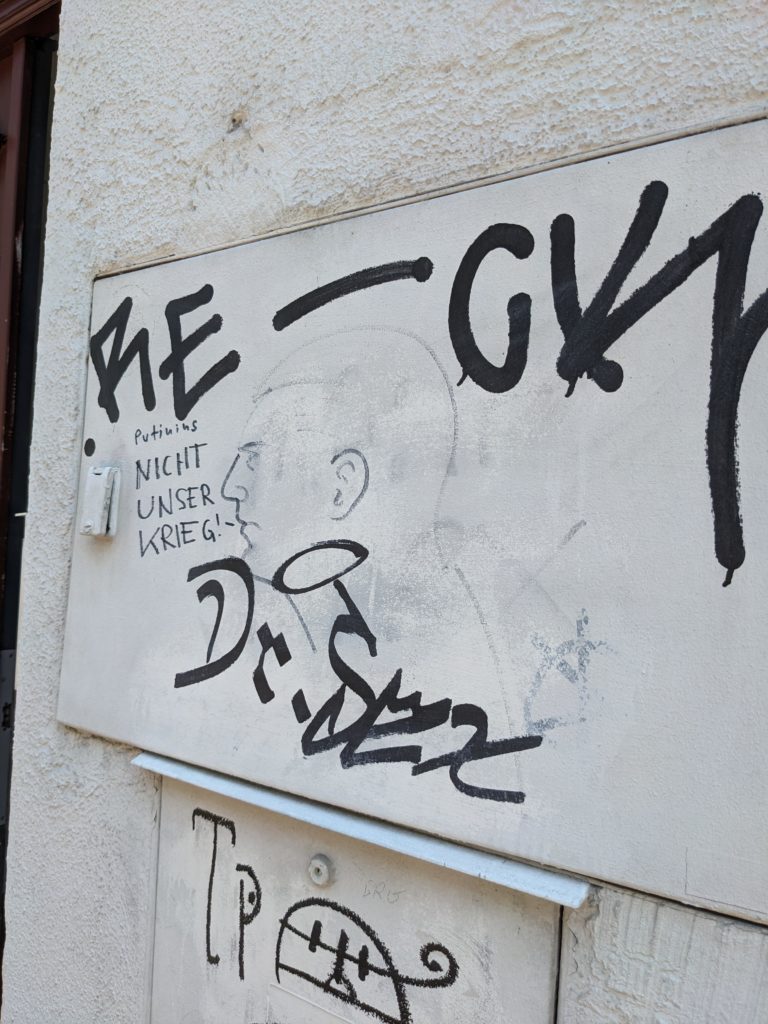



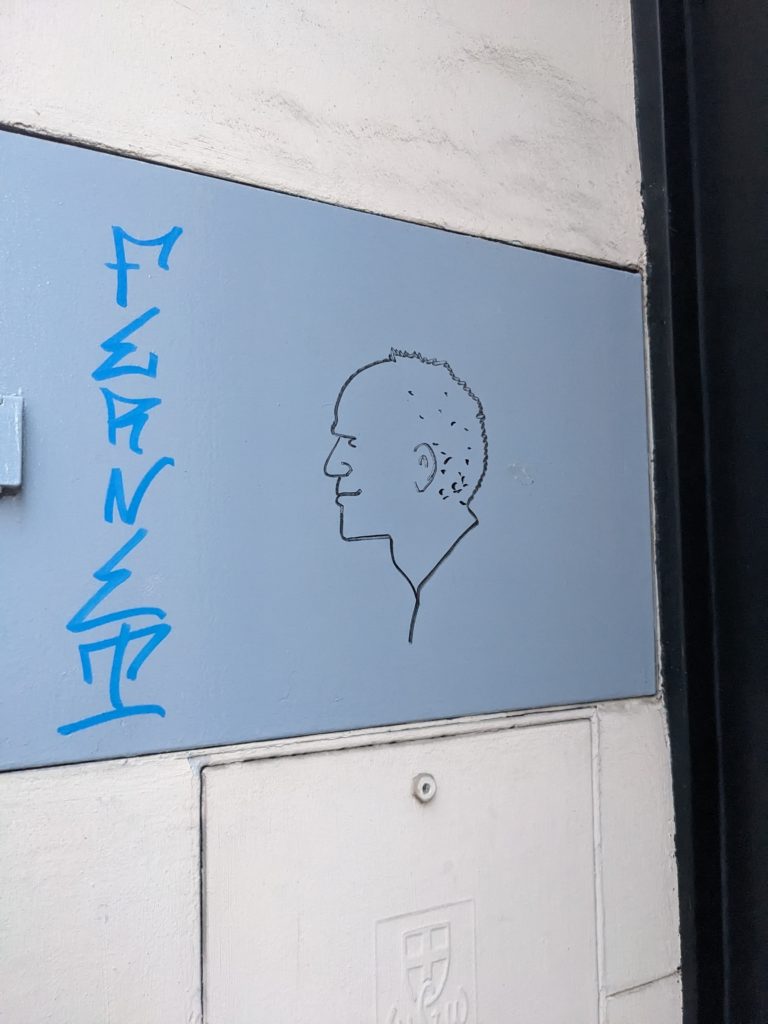
I’ve been photographing as I stumble across them. The typical canvas is the metal cover of what I guess is electronic plumbing and possible electric meter in the entrance ways to apartment complexes. Two portraits I have found have had words put in their mouths: nicht unser kreig — not our war. Presumably a statement against European support and involvement in Ukraine. I don’t believe they were the sentiments of the original artist. Nor reflective of the general mood on the street. I saw plenty of Fuck Putin stenciled about.
Vienna Diary, July 13th
The Vienna clock museum follow naturally from the globe museum. On some deep level the two museums are the two sides of the same temporal, geographic coin. As with globes, we take for granted how clocks determine our thinking about time. It feels to us like this absolute notion. As part of my work I regularly handle integer values that mark the number of seconds since January 1st 1970, the Unix epoch, which as far as a command line wizard is concerned, marks the true Common Era. I imagine you have to do a lot of astrophysics subject to effects of relativity to shake this absolute thinking.
The key scientific innovation in pendulum clocks is isochronism. First observed by Galileo, this means that the period of a pendulum — that is to say the time it takes to swing back and forth — doesn’t depend on the how big the swing of the pendulum is. So when you set a pendulum swinging, the first period takes the same amount of time as the hundredth, even though the pendulum by this point isn’t swinging as far. (Wikipedia tells me that this property is only approximately true). Thus regular increments of time can be measured out. Fortunately our days and calendar events happen with sufficient periodicity that they can be broken down in measurable fashion.
Also, I learned that people used to put working clocks into paintings to be hung with the dual painting/clock functionality.

Vienna Diary, July 11th
The Vienna Literaturmuseum provide digital tablets that, with certain prompting, give English translation of their main displays. So equipped, I was able to wander their rooms and follow the broad strokes of the history of Austrian literature. While I did manage to gain an appreciation of the big events and ideas, and learn which authors I should read (Joseph Roth, for one), I found the power of the museum, at least for me, was less educational and more the sheer spectacle of seeing this world of cursive script and typewritten pages that once existed. A world and a culture that we have definitively left behind.

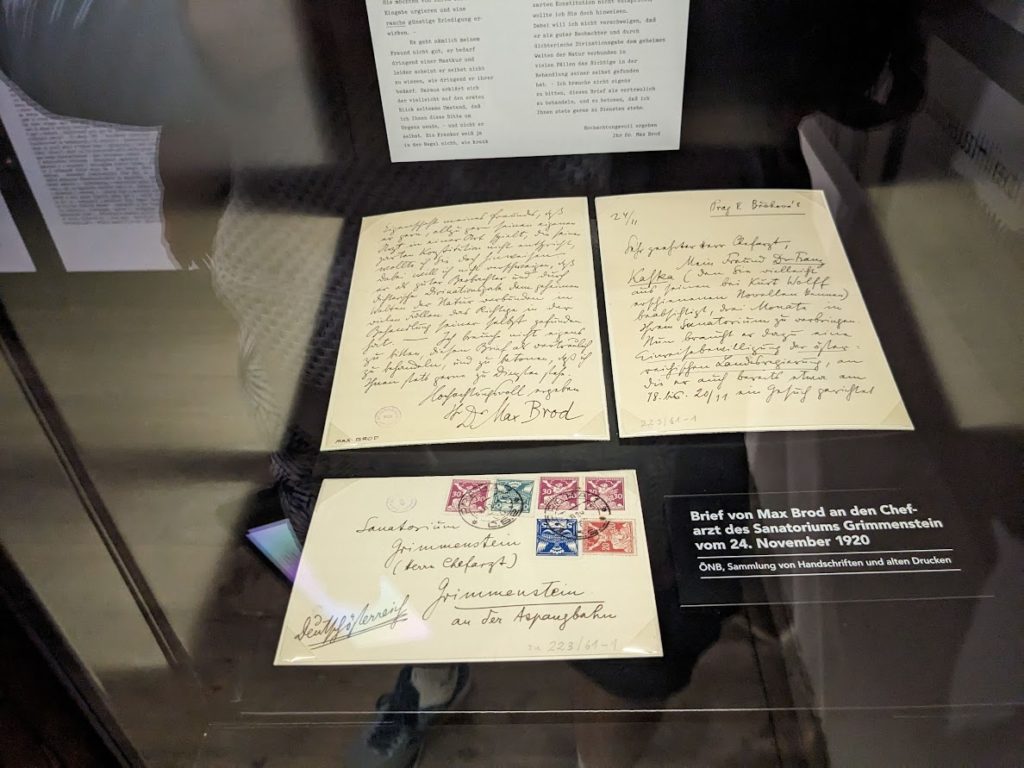



Vienna Diary, July 10th
In the late nineteenth and early twentieth centuries, Vienna was the best evidence that the most accommodating and fruitful ground for the life of the mind can be something more broad than a university campus. More broad, and in many ways more fun. In Vienna there were no exams to pass, learning was a voluntary passion, and wit was a form of currency.
Cultural Amnesia, Clive James
I read the opening to Clive James overture over a decade ago now, toward the end of my undergraduate degree. In retrospect it is clear that the aspiration it conveyed, and indeed the whole book conveyed, lodged itself deep in my mind. I did not read the entire book, following the practice of most readers, but jumped around the essays, ultimately moving on before the book’s depths were exhausted. It was the overture to the book that gave me a deep impression of what Vienna and specifically its cafe culture once was. It is probably the reason I first arrived in Vienna with greater expectations than when I visited Paris, even knowing what James informed me of: the abrupt end of it all with the finis Autriae.
Walking around Vienna it is hard not to think of how Twitter is collapsing — in corporate farce rather than facist horror (although, not coincidentally, there are plenty of nazis now on Twitter). For those who were lurking in the right corners and following the right people, the cultural significance of Twitter was easily comparable to Vienna’s cafes. James writes that for “generations of writers, artists, musicians, journalists and mind workers of every type, the Vienna cafe was a way of life”, and it is too good not to suggest that today they those very people have all become terminally online. He writes of Peter Altenberg who “hardly achieved anything at all” by the standards of his more famous cafe contemporaries, “But his very existence was a reminder to more prosperous practitioners that what they did was done from love“, and you think of all the legions of writers who hustled for work, readers, or even just likes on Twitter. Or you might read Stefan Zweig describing the cafe as “actually a sort of democratic club, open to everyone for the price of a cheap cup of coffee, where every guest can sit for hours with this little offering, to talk, write, play cards, receive post, and above all consume an unlimited number of newspapers and journals.” The unlimited number of newspapers and journals is so much on the nose, that the rising paywalls suggest another reason why the great age of Twitter discourse is at an end.
The fact that certain habitues received their mail in the cafes seemed amazing when I read it back in (maybe) 2011/12. But now I can check my email and my Whatsapps while in line at a Dunking Donuts.
Vienna Diary, July 10th
Wittgenstein’s Nephew by Thomas Bernhard is a novel, but also an authentic autobiographical account of the author’s relationship to Paul Wittgenstein — nephew to the famous philosopher and part of the once phenomenally wealthy Wittgenstein family. Like the celebrated philosopher, we are told that Paul did discarded, frittered, and give away his share of the wealth, and as time went on he became increasingly constant frustration to the rest of the family due to regular breakdowns and growing dependence on financial intervention. Bernhard very much liked Paul, having found in him an enlightened and fascinating friend; a man he judged to be quite unlike the rest of the family, who (excepting the celebrated philosopher) he despised.
I said it is an autobiographical account, but is it? It is hard not to wonder to what extent there is an element of performance. The opinions that thicken this text are extreme and scathing, and I presume are entirely sincere. He despises the countryside with the clear air that restores his ailing lungs, he despises the cafe culture for which Vienna is famous for, he despises the literary prizes he wins despite his persistence in offending all about him, he despises the upper classes, and he despises Austrian towns and cities for not carrying the Swiss daily he wants to read. I was waiting for him to despise apple strudle as well. If I came to the text without the modicum of context, I would have read the frank misanthropy of the narrator as being that deliberate ploy of unreliability. The novel is one unbroken, first-person paragraph, which I would have definitely identified as the unmistakable indicator of the unhinged.
In case you don’t know, Bernhard is regarded as one of the most important post-war Austrian literary figures. I will say this: it is a singular reading experience. It is also deeply frustrating, alluding to detail, to specifics, to events, without actually describing them. I think by now in the science of creative writing there is a consensus that specificity is a virtue in prose. What is not a virtue is the following shit:
I could recount not just hundreds, but thousands of Paul’s anecdotes in which he is the central figure; they are famous in the so-called upper reaches of Viennese society, to which he belonged and which, as everyone knows, have lives on such anecdotes for centuries; but I will refrain from doing so.
Wittgenstein’s nephew, page 60
Should I read that kind of sentence and continue to believe the author is writing in straight-forward good faith? By that point I was convinced he was fucking with me. Maybe there is some part of the continental European mentality that eludes me. I would have enjoyed Bernhard pulling back the curtain a little further on the “upper reaches” so disdained, and generously providing us with a little specificity. But maybe that is a vulgar inclination, and I too would be suspect under Bernhard’s gaze.
Vienna Diary, July 8th
We took a tram out the the MuseumsQuartier to visit the MUMOK on the understanding we would be treated to some expressionism. Whatever expressionist works they have remained a tease since that day they remained in the vault. Instead we found ourselves walking around an Adam Pendleton exhibition Blackness, White, and Light. I have little to say about it, and having read some of the exhibition text I had to wonder if anyone anywhere had anything worth saying about it.
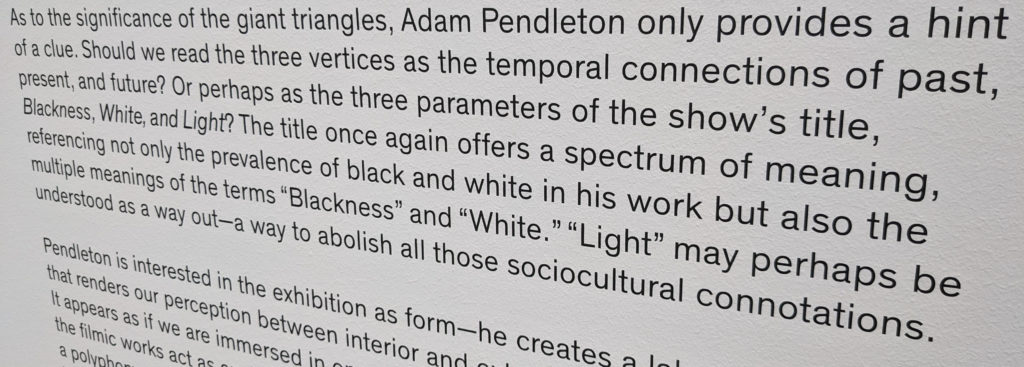
There was a room that formed part of the exhibition, that I did not enter, but have been reliably informed involved being bombarded with an upsetting and overwhelming stream of sound and images. Leaving the room so discombobulated gave the exhibition an entirely different hue, but I’m pretty certain you could have walked out into the Museum of Bad Art and found the effect similarly transformative.
There were also two floors showcasing the work of Elizabeth Wild, an Austrian collage artist who was at work throughout her life, but only received real art world recognition in her 90s. A lot of time passed between her studying at the Academy of Fine Arts Vienna and that eventual success. It was a life that involved fleeing unpleasant regimes and dictatorships at certain key junctures. The collages came late in her creative practice but she produced one a day, so there was an entire floor full of them. You might have already seen one of her collages on the London tube.

Vienna Diary, July 7th
I finished Measuring the World by Daniel Kehlmann. The novel recounts (with certain liberties and license) the lives of the German mathematician Carl Friedrich Gauss and the similarly German, but much wealthier, geographer Alexander von Humboldt. We are to understand that the pair were not motivated as other men and women of their time nor thought like others thought, and the material of their lives is presented with understated black humour and pathos at the loneliness their dedication to science and mathematics cost them.
I was particularly struck by the presentation of Gauss, whose mathematical powers read on the page as supernatural. He doesn’t merely have prescient ideas about how science and technology, but sees the actual that future will arrive, informing those around him as we might explain a new metro-line will gentrify the neighborhood. Like superman, he has arrived on a planet that is not his own, granting him insights as powerful as a Kryptonian’s strength is magnified under Earth’s weaker gravity. By the end Gauss is having ecstatic visions of a 21st century city. It would seem silly, were I not more than half convinced that it is deliberate. Nevertheless, I couldn’t help but suspect that the author might well understand the mathematics better than he understood the mathematician.
The penultimate chapter is a modernist tour de force, carried along on the momentum accumulated over the previous chapters. Up until that point Humbert and Gauss alternated chapters, providing an ostensibly conventionally styled account of the men’s lives. But then the narratives merge as the perspectives of the men are shared and the prose moves back and forth without announcement. I want to say it is one of the more effective employments of the modernist style that I have read. But perhaps it is fairer to say it the most accessible and generous to the reader.
Not everyone has been so taken with the text, however:

Hard to argue against the chap’s position of authority on the matter.
Vienna Diary, July 6
The Strudlhofstiege sits at a bend in a road that abruptly dead ends. And if you ascending the stairway and proceed onward you arrive at the mottled metal gates that announce the American embassy. A pair of fountains, asymmetric design, and Art Nouveau stylings set the Strudlhofstiege apart in obvious ways that don’t even require knowing what Art Nouveau actually is. A poem by the fish-faced fountain alludes to the literary significance of the site: a prominent location in the Great Austrian Novel Die Strudlhofstiege oder Melzer und die Tiefe der Jahre (The Strudlhof Steps or Melzer and the Depth of the Years) by Heimito von Doderer. I visit the Shakespeare and Company bookstore, but it is not among local offerings. (I settle for some Thomas Bernhard instead). Almost predictably, this Great Work was only published in English by New York Review Books Classics in 2021.

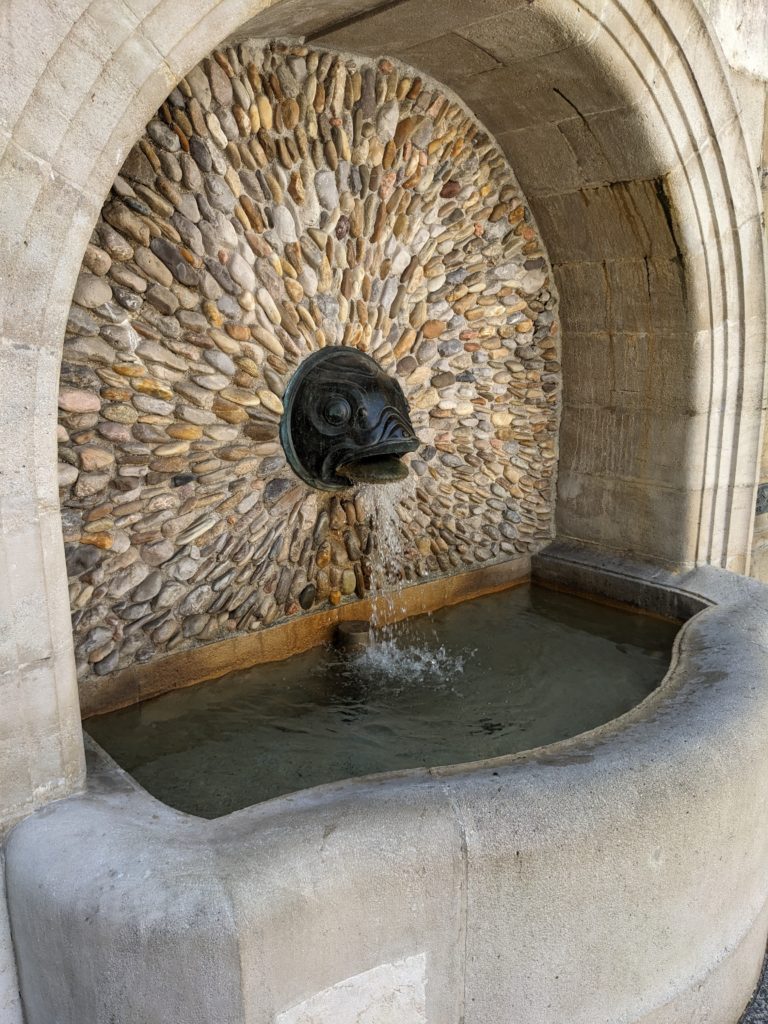

Confronting the Kugelmugel.

Whatever Christmas spirit I may have lacked for being in Israel, I was able to suitably redress by spending the first week of December in Vienna. The whole city feels like it was built to be decorated with gaudy winter lights.
I arrived on a Sunday afternoon, and after finding my hotel and getting dinner I decided I needed to go off on a bloody long walk. Walking is my principal source of exercise when I am taking these short trips, and I certainly wasn’t going to let the inclement weather get the better of me.
Rain will eventually threaten to get the best of you if your waterproof jacket doesn’t live up to it’s name so finding hot chocolate became a pressing concern. Vienna is world renowned for its cafe culture, but this led google maps to send me towards fancy coffee houses with startlingly long queues for admission. Whatever chain outlets existed weren’t open on a cold and wet Sunday evening. Fortunately, while most of the Christmas market had packed up and left, there was still one stall left open offering hot punch (spiced wine and rum) that was able to fortify me until I got back to the hotel.
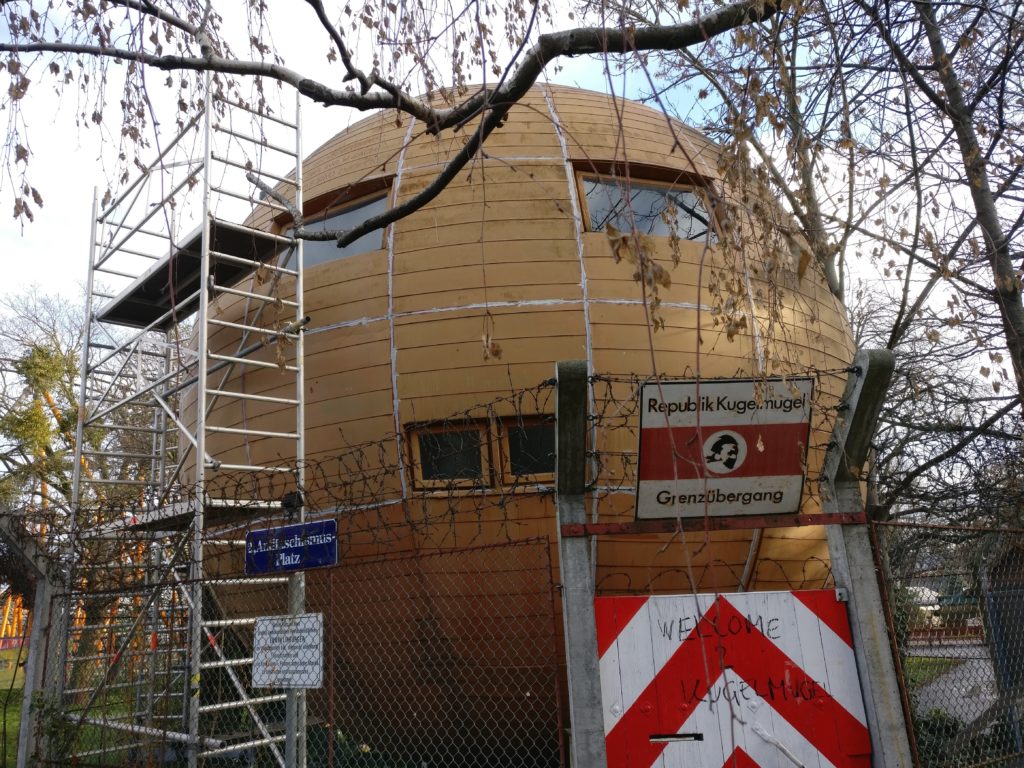
Vienna is renowned for it’s cultural history and visitors can behold the incredible architecture, visit one of the many museums, or experience the live music the city’s many music conservatories cultivate. I was only around for a week and most of the day time I was busy hallucinating about line patterns inside the free group. I did manage to spend one morning walking across the city. Given my limited window of opportunity I had to prioritize. So that meant the Museum of Art Fakes, and then the Republic of Kugelmugel.
In 1971 the Austrian artist Edwin Lipburger, with help from his son, built a spherical house for himself out of wood. As you can see from the picture above, the house isn’t just vaguely spherical. It is literally a sphere. Lipburger was apparently obsessed with the “cosmic harmony” of spheres. He christened his new home the Kugelmugel. The municipality of Vienna was less enamored with ball shaped houses, and as it turned out they had some kind of rule or regulation forbidding the construction of such a dwelling. This was the beginning of an ongoing dispute between Lipburger and the city that led to him declaring the Kugelmugel an independent state and would escalate to Lipburger going to jail for ten weeks — specifically for erecting unauthorized street signs.
Eventually, some kind of arrangement was reached when in 1982 the Kugelmugel was moved to Prater park, where it can today be found by the fun fair. Lipburger was apparently induced with the promise of electricity and running water, neither of which were ultimately provided. He was the Republic of Kugelmugel’s only citizen, and after his death in 2015, the Kugelmugel remains in Prader park as a strange tourist attraction.
Today the Kugelmugel stands among the growing ranks of the worlds micronations — the outsider artists in the world of statecraft. There have been many motivations for claiming your own independent ministate. In the UK the Principality of Sealand existed as a platform for pirate radio in the 60s and 70s. Lipburger’s own declaration of independence was made partly in protest but also as some kind of artistic statement. Although stamps and passports were issued, it is hard not to read his endeavor as a means of challenging the idea of a modern state, rather than a credible attempt to create one.
Whatever Lipburger’s intention, the impression it gave to this curious visitor was perhaps far from what he would have wanted. It is surrounded by an eight foot fence with barbed wire running across the top, and a sign above the gate give the impression of a former Soviet bloc country that doesn’t care for visitors. The sign marking the street Antifaschismus-Platz rings with an irony similar to the likes of the Democratic People’s Republic of Korea.
